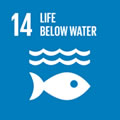Por favor, use este identificador para citar o enlazar a este item:
http://hdl.handle.net/10261/289774COMPARTIR / EXPORTAR:
 SHARE SHARE
 CORE
BASE CORE
BASE
|
|
| Visualizar otros formatos: MARC | Dublin Core | RDF | ORE | MODS | METS | DIDL | DATACITE | |

| Título: | Parasites and prey of the nursehound shark Scyliorhinus stellaris (Linnaeus, 1758): Insights into hidden trophic web interactions in the Mediterranean Sea |
Autor: | Santoro, Mario; Bellisario, Bruno; Fernández-Álvarez, Fernando Ángel CSIC ORCID; Crocetta, Fabio; Palomba, Marialetizia | Palabras clave: | Acanthobothrium coronatum Hexabothrium appendiculatum Parasite community Scyphophyllidium sp. Stomach contents Trophic-transmitted helminths Yamaguticestus sp. |
Fecha de publicación: | ene-2023 | Editor: | Fisheries Society of the British Isles | Citación: | Journal of Fish Biology 102(1): 271-280 (2023) | Resumen: | The metazoan parasite community and the stomach contents of the nursehound shark Scyliorhinus stellaris from the Gulf of Naples (central Mediterranean Sea) were studied. The nursehound shark harboured a poor parasite community composed of a species of gill monogenean (Hexabothrium appendiculatum) and three intestinal cestode taxa (Acanthobothrium coronatum and two unidentified species of the genera Yamaguticestus and Scyphophyllidium), all represented by adult stages. Hosts were mostly parasitized by individuals of A. coronatum, which was the most abundant species and contributed to almost 80% of the total number of parasites found. Conversely, other trophically transmitted parasites (i.e., Yamaguticestus sp. and Scyphophyllidium sp.) showed low prevalence and abundance. The parasite infracommunity was poor, showing low values of species richness, total mean abundance, and diversity indices. Overall, 52 prey items belonging to 13 taxa were identified in the stomach contents. Cephalopods were the most important prey items (represented by nine taxa) and the most diverse and abundant group. In the multivariate space provided by a principal component of mixed data (PCAmix), nursehound sharks distributed along two main axes, related to individual traits (first axis) and stomach contents (including empty ones, second axis). A logistic regression based on the first two axes of the PCAmix showed a significant influence of host individual traits and, to a lesser extent, of stomach contents, regarding the probability of being infected by A. coronatum. Alongside specific traits already associated with parasites transmission, our results highlight the importance of cephalopods in transferring cestode infections through trophic web interactions in the top-predator nursehound shark | Descripción: | 10 pages, 1 figure, 4 tables.-- Data Availability Statement: The authors confirm that the data supporting the findings of this study are available within the article | Versión del editor: | https://doi.org/10.1111/jfb.15259 | URI: | http://hdl.handle.net/10261/289774 | DOI: | 10.1111/jfb.15259 | ISSN: | 0022-1112 | E-ISSN: | 1095-8649 |
| Aparece en las colecciones: | (ICM) Artículos |
Mostrar el registro completo
CORE Recommender
SCOPUSTM
Citations
5
checked on 08-may-2024
WEB OF SCIENCETM
Citations
2
checked on 16-feb-2024
Page view(s)
32
checked on 16-may-2024
Google ScholarTM
Check
Altmetric
Altmetric
NOTA: Los ítems de Digital.CSIC están protegidos por copyright, con todos los derechos reservados, a menos que se indique lo contrario.


